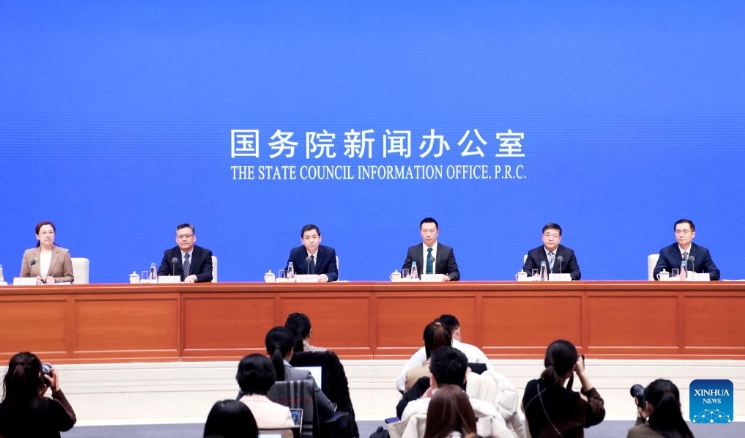
A press conference is held by the State Council Information Office in Beijing, capital of China, Nov. 28, 2024. (Xinhua/Pan Xu)
BEIJING, Nov. 28 (Xinhua) -- There is significant room to improve logistics efficiency in China, and the country has rolled out a plan to cut the ratio of social logistics costs to GDP to approximately 13.5 percent by 2027, down from 14.4 percent in 2023 and 18 percent in 2012.
That would mean China's logistics costs incurred for every 100 yuan (13.89 U.S. dollars) of GDP would decrease to 13.5 yuan in 2027, down from 14.4 yuan in 2023 and 18 yuan in 2012.
China should optimize its goods transportation structure further by 2027, and strengthen its national logistics hub system and modern logistics services network, according to a plan issued by the general offices of the Communist Party of China Central Committee and the State Council.
This is not about compressing the reasonable profits of logistics companies, nor is it about hurting the income of logistics practitioners, Zhang Shixin, deputy secretary general of the National Development and Reform Commission, said at a press conference on Thursday.
Zhang noted that the plan focuses on coordinating cuts of logistics costs with the high-quality development of modern logistics by adjusting structures, deepening reforms and optimizing logistics resource allocation.
It highlights reforms and innovation -- as institutional and mechanism reforms are crucial to improving logistics efficiency -- and focuses on key areas such as rail freight, road freight and logistics data.
The goal, or the 0.9-percentage-point cut from 2023 to 2027, is based on the traits of China's industrial structure and the operations of its logistics sector.
But what does a 0.9-percentage-point downtick mean for China? It means the country will save more than 1 trillion yuan in social logistics costs compared to 2023, which would be a boon for the real economy, Zhang said.
At the industrial level, it means a competitive edge in manufacturing, as the sector's logistics account for nearly 90 percent of the country's total logistics. Improved logistics efficiency will help streamline related procedures and facilitate transformation in the manufacturing sector.
The plan stresses the importance of reforms in key rail and road freight market areas, in the openness and interconnectivity of logistics data, in the construction of a modern supply-chain system, and in the modern commercial logistics system.
It also encourages new logistics models that integrate into the platform economy, the low-altitude economy and autonomous driving, and that promote the use of technologies in such areas as unmanned vehicles, boats, drones and warehouses.
Support will also be provided to make logistics hubs, warehouses and transportation facilities greener, per the plan. Logistics packaging will be reduced in volume and made more recyclable.
China's social logistics costs were 13.4 trillion yuan in the first three quarters of 2024, and its ratio of logistics costs to GDP was 14.1 percent, according to the China Federation of Logistics and Purchasing.
(Editor: wangsu )


